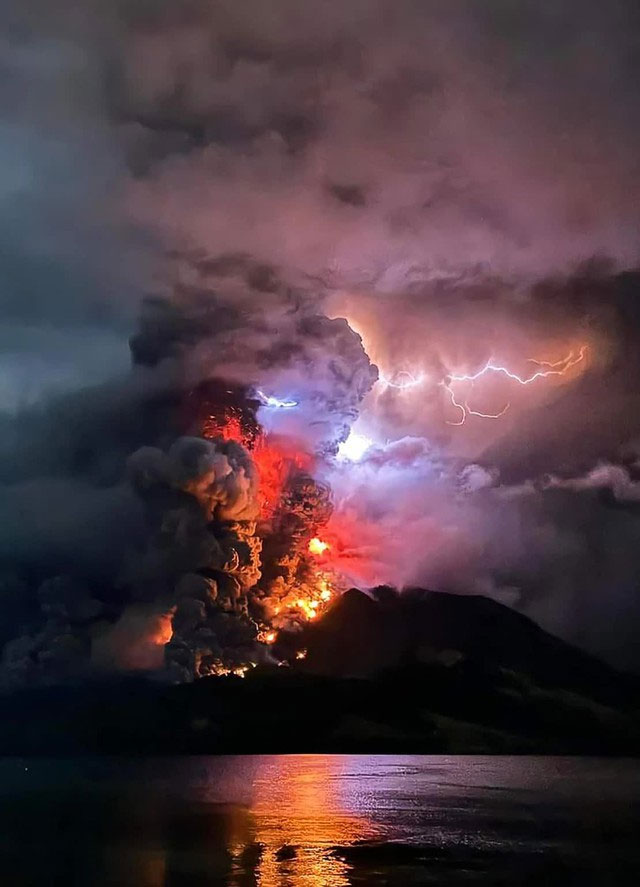Volcanic eruption in Indonesia makes new findings about climate
Ruang Volcano in Indonesia experienced multiple eruptions last week. The volcanic phenomenon was pushed so high that it reached the stratosphere of the atmosphere, estimated to be only dozens of feet above the ground.
According to satellite observations, the eruption at Ruang volcano created a huge plume of ash and a large amount of smoke that flew more than 65,000 feet into the air, estimated to be about 25,000 feet higher than what a plane could reach. Commercial airplanes often fly.
Indonesia's National Disaster Mitigation Agency (BNPB) has recorded at least 498 homes and 3 public facilities damaged by the eruption of Mount Ruang.

Ruang volcano spews lava and ash on April 17, seen from Sitaro, North Sulawesi. Volcanic eruptions also cause lightning in the ash cloud - a common phenomenon in powerful volcanic eruptions. (Photo: Center for Volcanology and Geological Hazard Reduction/AFP/Getty Images).
More than 11,600 residents in 12 villages in the Tagulandang sub-district of the Sitaro Islands were affected by the eruption. People were evacuated to emergency locations, churches and relatives' homes.
In recent times, the potential impacts of volcanic eruptions on weather and climate are beginning to attract the world's attention, even as the dangers posed by volcanoes persist and The evacuation of people continues.
Volcanoes can have short-term impacts on climate - including cooling global temperatures - due to the fumes they pump at high speed into the upper atmosphere. However, according to Mr. Greg Huey, Dean of the School of Earth and Atmospheric Sciences at Georgia Institute of Technology (USA), Mount Ruang's influence on the climate may only be minimal.
Volcanologists say Mount Ruang, a 2,400-foot (725-meter) stratovolcano on Ruang island in Indonesia's North Sulawesi province, has erupted at least seven times since last Tuesday night.
Stratovolcanoes can produce large eruptions when crushed solids create a lot of static electricity in the ash plumes as they collide, leading to strong glowing phenomena.
"Ash itself is short-lived in the atmosphere because it is heavy, large and tends to settle quickly. It is a gas that has the ability to fly much higher in the atmosphere ," Mr. Huey emphasized.
Weather effects following volcanic eruptions
Dense layers of ash near the surface create hazardous air quality and cause a temporary cooling effect by blocking warming sunlight. When the eruption stopped, the ash began to settle.
Once ash falls to the ground, it can still be easily blown back into the air by the wind. Water droplets often cling to ash in the air and form storm clouds that cause rain or generate additional lightning.
Gas rising from the eruption at Mount Ruang will enter the stratosphere, the second layer of the Earth's atmosphere. This gas is located just above the troposphere, where life and weather occur.
According to Mr. Huey, the stratosphere is a very dry place and only gases with long lifetimes - lasting decades - can filter into the stratosphere. However, volcanic eruptions are essentially the only natural way for gases such as short-lived sulfur dioxide and water vapor to enter the stratosphere.
Once in the stratosphere, sulfur dioxide and water vapor combine to create a layer of fog droplets. The fog droplets will spread far beyond the point of entry and remain in the stratosphere for up to 3 years, reflecting sunlight back into space and causing global temperatures to cool.
And the cooling effect would last longer if more gas entered the stratosphere.
In 1991, Mount Pinatubo – another stratovolcano – erupted in the Philippines and produced the largest cloud of sulfur dioxide ever measured. According to the US Geological Survey, the eruption poured more than 17 million tons of gas into the atmosphere and caused global temperatures to drop by about 0.5 degrees Celsius (0.9 degrees Fahrenheit) lasting about a year.
By comparison, satellite observations indicate that Mount Ruang has emitted about 300,000 tons of sulfur dioxide, although it is unclear how much of that has entered the stratosphere. According to Mr. Huey, although that amount is quite large, the prediction is not yet in the most extreme case.
An eruption as large as Mount Pinatubo in 1991 could certainly cool the planet for several years, although the natural disaster brought current climate woes on Earth due to pollution, dragging the planet with it. heat up with great damage to life and property.
- Volcanic eruption in Indonesia, 7 people died
- Volcanic eruption in Indonesia, 6,000 people evacuated
- This is the cause of the largest volcanic eruption in history
- Indonesia was shaken by volcanic eruptions and earthquakes
- The eruption was 10,000 times more powerful than the atomic bomb
- Decode the mysterious volcanic eruption in the 13th century
- Volcanic eruption in the Philippines, 5 people died
- Indonesia: The volcano erupted as thousands of bombs exploded
- Video: Japan's largest volcano
- Indonesia: Volcanic eruption, 6 people died
- Video: Volcanic eruption creates 9,000 m high smoke column in Japan
- The most brilliant volcanic eruption in the solar system
 Is the magnetic North Pole shift dangerous to humanity?
Is the magnetic North Pole shift dangerous to humanity? Washington legalizes the recycling of human bodies into fertilizer
Washington legalizes the recycling of human bodies into fertilizer Lightning stone - the mysterious guest
Lightning stone - the mysterious guest Stunned by the mysterious sunset, strange appearance
Stunned by the mysterious sunset, strange appearance